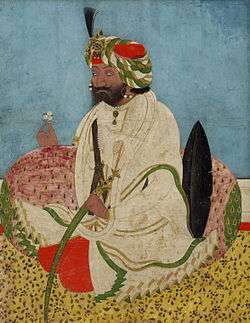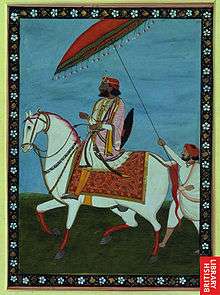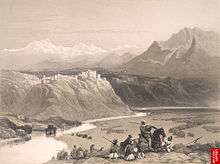Gulab Singh
| Gulab Singh | |
|---|---|
 | |
| Maharaja of Jammu and Kashmir | |
| Reign | 16 March 1846— 30 June 1857 |
| Predecessor |
Jit Singh As Raja of Jammu |
| Successor | Ranbir Singh |
| Born |
18 October 1792 Jammu |
| Died | 30 June 1857 (aged 64) |
| Issue | Ranbir Singh |
| Dynasty | Jamwal |
| Father | Kishore Singh |
| Religion | Hinduism |
Gulab Singh (1792–1857) was the founder of royal Dogra dynasty and first Maharaja of the princely state of Jammu and Kashmir, the second largest princely state in British India, which was created after the defeat of the Sikhs in the First Anglo-Sikh War. The Treaty of Amritsar (1846), formalised the sale by the British to Gulab Singh for 7,500,000 Nanakshahee Rupees of all the lands in Kashmir that were ceded to them by the Sikhs by the Treaty of Lahore.[1]
Early career

Gulab Singh was born on 18 October 1792 in a Hindu Jamwal Dogra Rajput family. His father, Kishore Singh Jamwal, was a distant kinsman of Jit Singh, the Raja of Jammu. Gulab Singh grew up in the care of his grandfather, Zorawar Singh, from whom he learned the arts of horse riding and warfare. In 1808, when the Sikh army of Maharaja Ranjit Singh invaded Jammu, the 16-year-old Gulab Singh fought alongside his clansmen in the unsuccessful defense of Jammu. Following this defeat, the Raja of Jammu had internal autonomy of the principality, which became a tributary of the Sikh Empire. In 1809, Gulab Singh headed towards Kabul to join the army of the Afghan King, Shah Shuja as a mercenary. When his men refused to cross the river Indus, he gained employment with Sardar Nihal Singh Attariwala. Soon thereafter, Gulab Singh was found employed as a running footman in Ranjit Singh’s court. He distinguished himself in several campaigns, including the conquest of Multan (1816). He also led an independent campaign in 1816 to conquer the hill-town of Reasi.
In 1816, following another conflict, Jammu was annexed by Ranjit Singh. Raja Jit Singh, who was expelled, found refuge in British India, and later received in appendage the estate of Akhrota. Ranjit Singh appointed a governor to administer the newly conquered area which was expanded in 1819 with the annexation of Kashmir by a Sikh force. In 1820, in appreciation of services rendered by the family, and by Gulab Singh in particular, Ranjit Singh bestowed the Jammu region as a hereditary fief upon Kishore Singh. Apart from their sterling services, the family's intimate association with the region commended Kishore Singh's candidature to the Lahore court.
In 1821, Gulab Singh captured conquered Rajouri from Aghar Khan and Kishtwar from Raja Tegh Muhammad Singh. That same year, Gulab Singh took part in the Sikh conquest of Dera Ghazi Khan. He also captured and executed his own clansman, Mian Dido Jamwal, who had been leading a rebellion against the Sikhs.
Raja of Jammu
Kishore Singh died in 1822 and Gulab Singh was confirmed as Raja of Jammu by his suzerain, Ranjit Singh. Shortly afterwards, Gulab Singh secured a formal declaration of renunciation from his kinsman, the deposed Raja Jit Singh. The declaration, drafted in Persian, reads:
- "I, Raja Jit Singh, grandson of Raja Sahib Ranjit Devji, on this occasion and out of internal inclination and dignified favors, in my own lifetime, and as a token of intrinsic love and heartfelt affection, hereby renounce proprietorship to all the protected territories of my ancestors, and my own inheritance, in favor of my prosperous barkhurdar, Raja-i-Rajgan Raja Gulab Singhji, and Raja Sahib Dhian Singhji and Raja Suchet Singhji, by way of dharam and niyam, mutual agreement and on oaths of my predecessors and Thakurs and Gurus."
Thus, the declaration transferred the headship of the Jamwal Rajputs to a junior branch of that clan.
Intrigue at Lahore
In 1824 Gulab Singh captured the fort of Samartah, near the holy Mansar Lake. In 1827 he accompanied the Sikh Commander-in-Chief Hari Singh Nalwa, who fought and defeated a horde of Afghan rebels led by Sayyid Ahmed at the Battle of Shaidu. Between 1831-39 Ranjit Singh bestowed on Gulab Singh the jagir of the salt mines in northern Punjab, and the nearby Punjabi towns like Bhera, Jhelum, Rohtas, and Gujrat.
On the death of Ranjit Singh in 1839, Lahore became a center of conspiracies and intrigue in which the three Jammu brothers were involved. They succeeded in placing the administration in the hands of Prince Nau Nihal Singh with Raja Dhian Singh as prime minister. However, in 1840, during the funeral procession of his father Maharaja Kharak Singh, Nau Nihal Singh together with Udham Singh, son of Gulab Singh, died when an old brick gate collapsed on them.
In January 1841 Sher Singh, son of Ranjit Singh, tried to seize the throne of Lahore but was repulsed by the Jammu brothers. The defence of the fort was in the hands of Gulab Singh. According to his American artillery commander Alexander Gardner:
- "The Dogras on the walls began to look over and were jeered at by Sher Singh’s troops, the little fort was surrounded by a sea of human heads. Gulab Singh made contemptuous replies, and roared out to Sher Singh, demanding that he should surrender... With a wild yell some 300 Akalis swept up the Hazuri Bagh and crowded into the gate. Just at that moment, when the crowd was rushing in on us, their swords high in the air, I managed to fire the ten guns, and literally blew them into the air... Then Sher Singh fled and grievous carnage ensued. The Dogras, always excellent marksmen, seemed that day not to miss a man from the walls... we counted the bodies of no less than 2800 soldiers, 200 artillerymen, and 180 horses."
After peace was made between the two sides, Gulab Singh and his men were allowed to leave with their weapons. On this occasion, he is said to have taken away a large amount of the Lahore treasure to Jammu. Subsequently, Gulab Singh conquered the fort of Mangla (near the present Mangla Dam on the Jhelum River).
Clashes with the Muslim tribes of Kashmir and Hazara
In 1837, after the death of Hari Singh Nalwa in the Battle of Jamrud, the Muslim tribes of Tanolis, Karrals, Dhunds, Satis and Sudhans rose in revolt in Hazara and Kashmir. Gulab Singh was given the task of crushing the rebellion. After defeating insurgents in Hazara and Murree hills, Gulab Singh made Kahuta his headquarter to deal with Kashmiri insurgents. A Sudhan, Shams Khan had raised the standard of revolt and had captured hill forts from a Raja. Gulab Singh placed one Rupee over the head of man, woman or child connected to the insurgents, this way about 12,000 Sudhans, Satis and Dhunds perished in the hills. Some Muslim women were taken captives and sold into sexual slavery.[2]

Trans-Himalayan adventure
In all this time a large part of the Dogra army had been engaged in trans-Himalayan conquests. General Zorawar Singh, governor of Kishtwar, had conquered the Suru valley and Kargil (1835), the rest of Ladakh (1836–40), and Baltistan (1840). These conquests had alarmed Mian Singh, the Sikh governor of Kashmir, who complained to Prince Nao Nihal Singh that “Zorawar Singh, agent of Raja Gulab Singh was obtaining complete possession of Baltistan” (Punjab Akhbars, 20 July 1840). The Dogra campaign threatened the Sikh position in Kashmir and Gilgit and so Zorawar Singh turned his attention east to the conquest of Tibet (see Sino-Sikh War).
In May 1841, the 5000 strong Dogra army supplemented by contingents of Kishtwaris, Ladakhis, and Baltis (raising the strength of the army to 7000) advanced eastwards in three divisions. Overcoming all the Tibetan opposition they set up base at Taklakot near the holy Mansarovar Lake in September 1841, after traversing a distance of 450 miles from the Indian frontier. With the onset of severe winter the Dogras began falling one-by-one to the extreme cold and the lack of provisions, many burning the stocks of their muskets in futile attempts to warm themselves, and were overcome by a Tibetan force on 12 December 1841. Survivors of this campaign crossed over the Himalayas south to the British territories. Gulab Singh who was then in Peshawar leading the Anglo-Sikh campaign in Afghanistan was informed of this disaster by Henry Lawrence.
The Tibetans then invaded Ladakh but were defeated by the Dogras at the Battle of Chushul. The boundary between Ladakh and Tibet was finally settled by the Treaty of Chushul.
Recognition as Maharaja

Meanwhile, in the continuing intrigues at Lahore the Sandhawalia Sardars (related to Ranjit Singh) murdered Raja Dhian Singh and the Sikh Maharaja Sher Singh in 1842.[3] Subsequently Gulab Singh’s youngest brother, Suchet Singh, and nephew, Hira Singh, were also murdered. As the administration collapsed the Khalsa soldiery clamored for the arrears of their pay. In 1844 the Lahore court commanded an invasion of Jammu to extract money from Gulab Singh, reputed to be the richest Raja north of the Sutlej River as he had taken most of the Lahore treasury.
However the Gulab Singh agreed to negotiate on his behalf with the Lahore court. These negotiations imposed an indemnity of 27 lakh Nanakshahee Rupees on the Raja. After the Anglo-Sikh wars, under the Treaty of Lahore the defeated Lahore court was made to transfer Jammu to Gulab Singh.
Lacking the resources to occupy such a large region immediately after annexing portions of Punjab, the British recognized Gulab Singh as a Maharaja directly tributary to them on payment of 75 Lakh Nanakshahee Rupees for the war-indemnity (this payment was justified on account of Gulab Singh legally being one of the chiefs of the Kingdom of Lahore and thus responsible for its treaty obligations). The angry courtiers of Lahore (particularly the baptised Sikh, Lal Singh) then incited the governor of Kashmir to rebel against Gulab Singh, but this rebellion was defeated, thanks in great part to the action of Herbert Edwardes, Assistant Resident at Lahore.
This arrangement was formalized in the Treaty of Amritsar in 1846. In the second Sikh War of 1849, he allowed his Sikh soldiers to desert and go to fight alongside their brethren in Punjab. The treaties of Chushul and Amritsar had defined the borders of the Kingdom of Jammu in the east, south and west but the northern border was still undefined. In 1850 the fort of Chilas in the Dard country was conquered. Gilgit was lost to rebellion in 1852, but was recovered ten years later by his son.
Maharaja Gulab Singh died on 30 June 1857 and was succeeded by his son, Ranbir Singh.
Notes
- ↑ Panikkar, K. M. (1930). Gulab Singh. London: Martin Hopkinson Ltd. p. 112.
- ↑ Hastings Donnan, Marriage Among Muslims: Preference and Choice in Northern Pakistan, (Brill, 1997), 41.
- ↑ J. S. Grewal (1998). The Sikhs of the Punjab. Cambridge University Press.
Further reading
| Wikimedia Commons has media related to Gulab Singh of Jammu and Kashmir. |
- How Sikhs Lost their Empire by Khushwant Singh
- Gulabnama by Dewan Kirpa Ram, translated by Professor SS Charak
- Memoirs of Alexander Gardner by Hugh Pearse
| Gulab Singh Born: 18 October 1792 Died: 30 June 1857 | ||
| Regnal titles | ||
|---|---|---|
| Preceded by Jit Singh (as Raja of Jammu (tributary to the Sikh Empire)) |
Maharaja of Jammu and Kashmir 1846–1857 |
Succeeded by Ranbir Singh |
